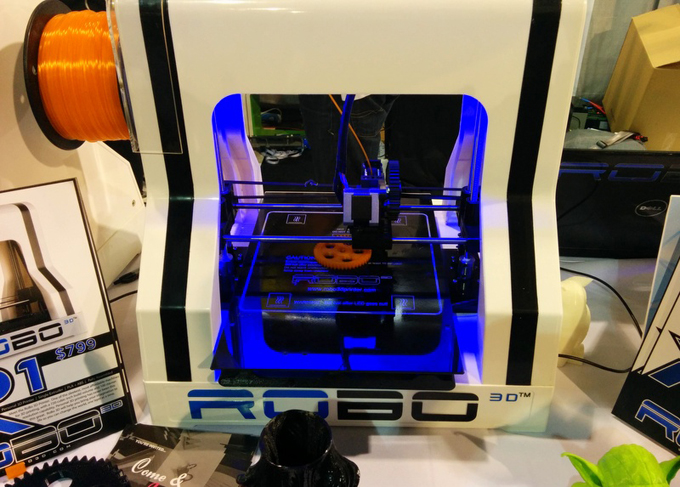My next stop was the Formlabs booth. I’ve been following them closely since the initial crowdfunding of the Form 1 printer back in September of 2012. The project was launched on Kickstarter with a goal of raising $100,000 and in 30 days raised nearly $3 million, making it one of the most successful projects ever. The Form 1 is the first desktop stereolithography (SL) printer to reach the market and will retail for $3,299. The company is taking pre-orders now and expects to ship in April, 2014.
I was looking forward to getting an up close look at both the printer and its quality of output. I was able to touch and hold the now famous Eiffel Tower model and was amazed at the level of detail. The quality of resolution offered by the Form 1 represents a huge leap forward for desktop 3D printing.
Right across the hall was another stereolithography based model, the XLab printer from Italian manufacturer Digital Wax Systems (DWS.) DWS has been around since 2007 and is known for the wax-based additive manufacturing technology commonly used in jewelry and dental applications, among others. Their announcement at CES was of a resin-based SL printer to compete with the Form 1. In addition to resin, it will also print in other substrates including ceramic and rubber. Pricing and availability were not announced.
My next stop was to the XYZ Printing exhibit to check out the new Da Vinci 1.0 printer. This new printer uses the same fused deposition modeling (FDM) technology offered in the 3D Systems Cube and MakerBot printers, but will be available at a very low $499 price tag. The machine seems well built and offers good quality. It should help further commodotize the cost of 3D printing.
Another upstart, Pirate 3D also hopes to make home 3D printing more affordable with the upcoming launch of its Buccaneer printer. Also a Kickstarter effort, Pirate 3D had a goal of $100,000 and raised over $1.4 million in 30 days. Pirate 3D is taking pre-orders for the Buccaneer now, and like the Da Vinci it’s available for under $500.
Crowdfunding and 3D printing have been very good for one another.
3Doodler was the next booth I visited. The 3Doodler is a pen that allows you to draw freehand in 3D. It was also a Kickstarter project with a goal of $30,000. In 30 days it raked in over $2.3 million. Just down from there, the Hyrel 3D printer was on display in the 3D Printlife both. It’s crowdfunding project on Kickstarter had a goal of $50,000 and in 30 days raised $150,000.
Combined, the 3D Printing TechZone housed over $7 million in crowdfunded products, including some of Kickstarter’s most successful projects.
My next stop was to the mcor exhibit. I’d had the opportunity to see their Iris printer up close on a couple occasions before but wanted to meet the team behind it. I’m connected on LinkedIn with mcor’s Marketing Director, Julie Reece, and looked forward to introducing myself in person. She was very hospitable, introducing me to CMO Deidre MacCormack, and later CEO Connor MacCormack.
If you’re not familiar with mcor, their printers build 3D printed objects from ordinary copy paper. Sheets are feed into the machine, digitally die-cut, glued and stacked upon one another to build the object. In addition, the device can make full color objects by spraying ink (via inkjet) on the exterior. The only other technologies that offer 3D printing in full color use gypsum or sandstone powder and tend to be very brittle. The mcor’s paper-based process is more durable and generally less expensive.
It also has the advantage of being more familiar to those from the traditional printing industry. While I was standing there, the owners of a large commercial print company stopped by to check it out. The looks on their faces were priceless as the mcor team explained how the machine used paper and ink to create 3D products.
Beyond the device manufacturers, others including software firms, service providers, and industry media outlets were also present. Over the course of the three days I was at CES, I spent several hours each day in the 3D Printing TechZone. Every booth was busy nearly all the time. I saw nearly every badge type, from attendees, to exhibitors, press and industry analysts. Even Martha Stewart stopped by to check it out.
I’ve got a bunch more to share, but you’re probably already rubbing your eyes and wondering when this is going to end. So I’ll spoon feed it, one chunk at a time. In the next article, I’ll talk more about the applications – the cool things people were actually printing and displaying at CES. In the finale I’ll share my thoughts on how this hugely disruptive technology might impact the consumer products industry as a whole. By the time you can see straight again, I’ll be back with another installment.

